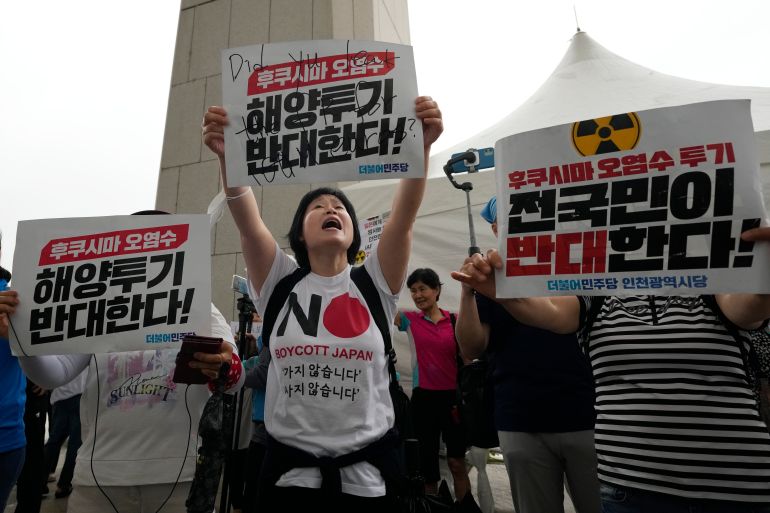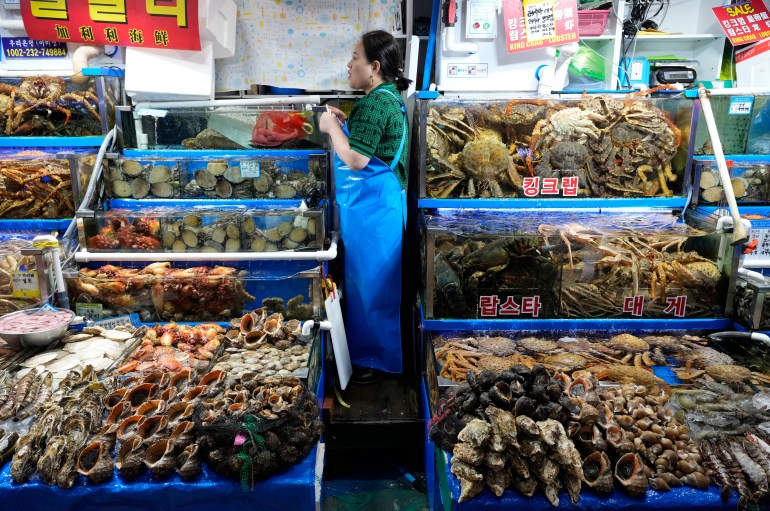Japan turns to livestreamed fish in Fukushima safety campaign
Fish swimming in a tank of treated water are part of a multi-million dollar campaign to convince people it’s safe to release the radioactive water.

Tokyo, Japan – Japan has launched a torrent of advertising campaigns to help convince a sceptical public that releasing treated radioactive wastewater from the tsunami-wrecked Fukushima plant into the ocean is safe.
Details of the release – which could begin as early as August – are broadcast on TV and in railway stations. The Japanese government has also set up a livestream of fish living in a tank of the treated wastewater and published articles in newspapers as evidence of its plan’s safety.
Keep reading
list of 4 itemsWhy is Japan’s Fukushima water release so controversial?
Japan begins final checks on system to release Fukushima water
Protests grow in South Korea over Japan’s Fukushima water plan
Public events and festivals are also under way. At high schools nationwide, authorities have held forums to “provide an opportunity for the younger generation, who will be responsible for the future, to learn about and think about these issues”.
Such multifaceted campaigning is an attempt to quell fears over Japan’s plan to release more than 1.3 million tonnes of treated radioactive water into the Pacific, a plan that has drawn condemnation at home and abroad.
The Japanese government maintains the process is safe.
The accumulated water – enough to fill 500 Olympic-sized swimming pools – was used to cool the fuel rods of the Fukushima plant after it was damaged by the earthquake and huge tsunami that hit northeastern Japan in March 2011. It has already been treated with a system called Advanced Liquid Processing System (ALPS), removing most radioactive nuclides.

A week ago, the United Nations’s nuclear watchdog further validated Japan’s plan, a key part of the decommissioning of the ravaged plant, by stating that it met global safety standards. After a two-year review, the International Atomic Energy Agency (IAEA) concluded that the release would have a “negligible radiological impact to people and the environment”, a conclusion echoed by scientists.
But despite such reassurance and the approximately 3 billion yen ($20m) the government has pooled for public relations projects, criticism from neighbouring countries, particularly China but also South Korea, keeps mounting, proving how difficult it will be for Japan to convince the general public of its plan’s safety.
‘Propaganda’
On July 4, Beijing came out strongly against the wastewater release.
“Simply for saving cost, Japan has insisted on discharging the nuclear-contaminated water into the sea in disregard of the concerns and opposition from the international community and taken the Pacific Ocean as the ‘sewer’,” a spokesperson for China’s foreign ministry said.
The South Korean government, on the other hand, said on Friday that it respected the IAEA’s conclusions after conducting its own assessment of Japan’s discharge plan. But the backlash is mounting among consumers, who have been panic-buying sea salt, which they fear could be contaminated by the release, contributing to a 27 percent rise in the price of salt in June compared with two months ago.
At home, the Japanese government has met fishermen, some of the most vocal critics of the planned discharge. Many fishing unions fear reputational damage, which they experienced after the 2011 disaster when several countries banned some products they sold.
To reduce the risk of such damage, the government has set up funds to financially support the fishing industry. It has also held several food tourism events and enlisted influencers to promote how safe the food in Fukushima will be, even after the release.
But the tactics employed by the Japanese government feel like “propaganda”, Shohei Makiuchi, a freelance journalist who has covered the Fukushima wastewater release extensively, told Al Jazeera.
“Instead of allowing an open discussion about what Japan should do with the treated radioactive wastewater, the government is merely telling the public, one-sidedly, that the plan is safe,” he said.
Bedi Racule, an antinuclear activist from the Marshall Islands – which was used as a testing ground for atomic bombs by the United States between 1946 and 1958 – echoes Makiuchi’s concerns about how the Japanese government has been promoting its wastewater release.
Referencing Japan’s development aid to the Pacific Islands, which includes loans, maritime capacity building and humanitarian assistance, Racule said, “There is a sense of concern that Japan and other superpowers are trying to divide and conquer our Pacific leaders by using development assistance as a political tool to pursue their own interests.”
“If Japan is truly our friend, it will not cause transboundary harm to Pacific nations by proceeding with the dumping,” she added.
Tritium everywhere
Although it is difficult to tell how effective the advertising campaign will be at swaying public opinion – and criticism of Japan’s plan remains robust – recent polls suggest opinions are slowly changing.
In a February 2022 poll conducted by the newspaper Asahi Shimbun, the majority of respondents were against the discharge, at 45 percent. But in March this year, more were for the release, at 51 percent.
Paul Dickman, a radiochemist who has visited Fukushima multiple times over the past decade to advise Japanese regulators on the nuclear waste cleanup, endorses Japan’s plan to release the treated wastewater into the Pacific. Although the discharge will contain low traces of tritium, a radioactive isotope of hydrogen, Dickman noted it is standard practice to release this radioactive material into the ocean – as countries like China and South Korea already do.
He pointed out that the treated wastewater will be diluted well below global safety limits and released slowly over a 30- to 40-year period, meaning traces of radioactivity in the water will have a negligible effect on human health.
“The air you breathe, the water you drink, the food you eat all contain tritium; they always have and at this level, it’d be just a part of our natural environment,” Dickman said.
The plant is owned by Tokyo Electric Power Company (TEPCO), and some scientists remain sceptical about the release, in part due to TEPCO’s spotty record of communicating with the public and the belief that the disaster was preventable. They are calling for transparency in sampling and monitoring, while others have expressed concern at the as-yet-unknown effect of long-term exposure to radionuclides.
Earlier this year, a panel of independent scientists advising the Pacific Islands Forum – a regional bloc of 17 island nations – urged Japan to delay the release because the data did not sufficiently prove the discharge would be harmless.
Japanese Prime Minister Fumio Kishida acknowledged these concerns in his meeting with IAEA Director General Rafael Grossi last week and sought to provide reassurance that public safety had the utmost importance.
“Japan will continue to provide explanations to the Japanese people and to the international community in a sincere manner based on scientific evidence and with a high level of transparency,” Kishida promised.
Grossi is visiting South Korea, New Zealand and the Cook Islands to reassure people there about the discharge. Meanwhile, some South Korean legislators are in Japan this week to make clear their objections.
On Wednesday they said they wanted more expert organisations to be involved in reviewing the discharge plan, in a statement that was also signed by a number of members of the Japanese parliament.
Convincing the doubtful of the plan’s benefits, it seems, might need more than a livestream of some Fukushima fish.